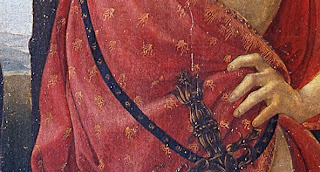When I was thinking about planning my last trip to Italy which included going on one of Vima deMarchi Micheli's Italia Mia tours, Vima asked me if I'd be interested in taking an embroidery course in Florence at the end of the tour. I said yes without thought to the teacher or the technique, knowing that it would be an experience that I wouldn't want to miss regardless of subject matter.
It's always great to discover that you've made the right decision by going with your instincts. Our course was three afternoons with all materials included, held in the delightful Residence La Contessina where we were staying. Our teacher was the very talented Adriana Armanni of the needlework school Arti e Pensieri® in Florence. (There is a lovely article about her here (in Italian) from 2003.)
 |
| Cover of course material. |
The technique was Florentine Whitework mounted on a frame inspired by a Rovescia which traditionally was the "pretend" fold-back part of the top sheet of the matrimonial bed. This was used to "dress-up" the matrimonial bed for when visitors came to call and was removed before going to sleep. I didn't get a clear photo of the whole piece but you can get an idea of the embroidery from the course booklet cover pictured above (click on the photo for a closer look).
 |
| Antique Rovescia found in a local flea market. |
Adriana modelled this course on an antique Rovescia that she found in a local flea market. She also had matching pillow cases which were traditionally part of the set. The work was stunning and so delicate! Not willing to burn a thread from her pieces in order to understand what kind of fabric it was, Adriana said that it was either very fine Cambric linen or cotton or very fine Batiste linen and in fact, it was very, very sheer. The sheerness of the fabric is essential to the work as the embroidery is designed to use a combination of stitches to achieve an overall balance of chiaroscuro effect.
The Rovescia was traditionally embroidered with sayings like this one, Felici Sonni = Sweet Dreams. Classic embroidery stitches are used like padded satin stitch, shadow work, French knots, stem stitch, long and short stitch and pulled and/or drawn thread stitches. It is important that the fabric be stretched on an embroidery frame in order to achieve an "embossed" effect which would be impossible if the work were done in hand. Good lighting and magnification are essential as the work is very fine.
 |
| Adriana instructs our "non-embroiderer". |
Our own project was not executed with materials as fine as the original but we were still able to achieve the look with the threads and fabrics that Adriana had chosen for us. There was one lady in our course who was not an embroiderer and she was able to produce some lovely results.
 |
| The huge embroidery frames we worked on. |
Adriana was able to provide the non-Italian speaking pupils with a booklet in English and provide assistance and instruction in English as well. She not only taught us the practical needlework execution but also the principals and science of the choice of stitches to be used when choosing what to fill the motifs with. This made me immediately think of my blog readers who have asked me where they can take a needlework course taught in English in Italy. Adriana is well-versed in all kinds of needlework techniques and you could contact her to choose one for yourself on your next trip to Florence. I found her to be a patient and well-explained teacher, she was full of tips and tricks that you only really learn from experience. Since she also does commissioned work as well as teaching needlework, you know that she is very good at what she does.
 |
| Detail of model piece. |
 |
| Detail of model piece. |
 |
| Detail of model piece. |
When I asked Adriana if she would mind if I wrote a post about our class and published my photos she said that she would be more than happy. She believes that needlework will only be kept alive by sharing knowledge. This is truly an important attitude and one that you don't always find amongst needlework teachers in Italy, many prefer to jealously guard their secrets.
At the end of our three days we had covered quite a lot of stitches and Adriana then unmounted and cut up the fabric so that we could each have enough to make a pillowcase of our work completed at home.






















